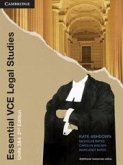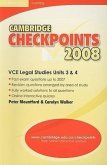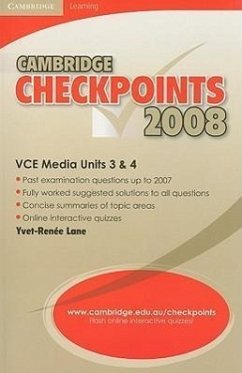Kate Ashdown, Nicholas Bates, Carolyn Walker, Margaret Bates
Essential Vce Legal Studies Units 3 and 4 Second Edition Bundle
Kate Ashdown, Nicholas Bates, Carolyn Walker, Margaret Bates
Essential Vce Legal Studies Units 3 and 4 Second Edition Bundle
- Broschiertes Buch
- Merkliste
- Auf die Merkliste
- Bewerten Bewerten
- Teilen
- Produkt teilen
- Produkterinnerung
- Produkterinnerung
Essential VCE Legal Studies Units 3&4 2nd Edition combines compelling and accessible language and layout with genuinely engaging features.
Andere Kunden interessierten sich auch für
![Essential Vce Legal Studies Units 3 and 4 Second Edition Pack Essential Vce Legal Studies Units 3 and 4 Second Edition Pack]() Kate AshdownEssential Vce Legal Studies Units 3 and 4 Second Edition Pack109,99 €
Kate AshdownEssential Vce Legal Studies Units 3 and 4 Second Edition Pack109,99 €![Cambridge Checkpoints Vce Legal Studies Units 3 and 4 2008 Cambridge Checkpoints Vce Legal Studies Units 3 and 4 2008]() Peter MountfordCambridge Checkpoints Vce Legal Studies Units 3 and 4 200826,99 €
Peter MountfordCambridge Checkpoints Vce Legal Studies Units 3 and 4 200826,99 €![Essential Vce Business Management Units 3 and 4 Bundle Essential Vce Business Management Units 3 and 4 Bundle]() Gillian SomersEssential Vce Business Management Units 3 and 4 Bundle111,99 €
Gillian SomersEssential Vce Business Management Units 3 and 4 Bundle111,99 €![Cambridge Hsc Legal Studies Pack Cambridge Hsc Legal Studies Pack]() Paul MilgateCambridge Hsc Legal Studies Pack106,99 €
Paul MilgateCambridge Hsc Legal Studies Pack106,99 €![Cambridge Checkpoints Vce Psychology Units 1 and 2 Cambridge Checkpoints Vce Psychology Units 1 and 2]() Max JoryCambridge Checkpoints Vce Psychology Units 1 and 244,99 €
Max JoryCambridge Checkpoints Vce Psychology Units 1 and 244,99 €![Cambridge Checkpoints Vce Media Units 3 and 4 2008 Cambridge Checkpoints Vce Media Units 3 and 4 2008]() Yvet-Renee LaneCambridge Checkpoints Vce Media Units 3 and 4 200826,99 €
Yvet-Renee LaneCambridge Checkpoints Vce Media Units 3 and 4 200826,99 €![Essential Vce Business Management Units 1 and 2 Essential Vce Business Management Units 1 and 2]() Gillian SomersEssential Vce Business Management Units 1 and 224,99 €
Gillian SomersEssential Vce Business Management Units 1 and 224,99 €-
-
-
Essential VCE Legal Studies Units 3&4 2nd Edition combines compelling and accessible language and layout with genuinely engaging features.
Hinweis: Dieser Artikel kann nur an eine deutsche Lieferadresse ausgeliefert werden.
Hinweis: Dieser Artikel kann nur an eine deutsche Lieferadresse ausgeliefert werden.
Produktdetails
- Produktdetails
- Verlag: Cambridge University Press
- 2nd Revised edition
- Seitenzahl: 428
- Erscheinungstermin: 12. Oktober 2010
- Englisch
- ISBN-13: 9780521171083
- ISBN-10: 0521171083
- Artikelnr.: 42092057
- Herstellerkennzeichnung
- Libri GmbH
- Europaallee 1
- 36244 Bad Hersfeld
- gpsr@libri.de
- Verlag: Cambridge University Press
- 2nd Revised edition
- Seitenzahl: 428
- Erscheinungstermin: 12. Oktober 2010
- Englisch
- ISBN-13: 9780521171083
- ISBN-10: 0521171083
- Artikelnr.: 42092057
- Herstellerkennzeichnung
- Libri GmbH
- Europaallee 1
- 36244 Bad Hersfeld
- gpsr@libri.de
Units 3 & 4
Introduction
Unit 3: Law-making
Area of Study 1: Parliament and the citizen
Part I: 1.1 Principles of the Australian parliamentary system
1.2 Structure of the Commonwealth and Victorian Parliaments and roles played by the Crown and Houses of Parliament in law-making
1.3 Reasons why laws may need to change
1.4 The Victorian Law Reform Commission
1.5 Means by which individuals and groups influence legislative change
1.6 Legislative process for the progress of a bill through parliament
1.7 Strengths and weaknesses of Parliament as a law-making body
Area of Study 2: The Constitution and the protection of rights
Part II: 2.1 Division of law-making power between state and Commonwealth parliaments under the Commonwealth Constitution
2.2 Restrictions imposed by the Commonwealth Constitution on the law-making powers of the state and Commonwealth parliaments
2.3 Process of change by referendum under Section 128 of the Commonwealth Constitution
2.4 Way in which one successful referendum changed the division of law-making powers
2.5 Role of the High Court in interpreting the Commonwealth Constitution
2.6 Significance of two High Court cases involving the interpretation of the Commonwealth Constitution
2.7 Capacity of the states to refer law-making power to the Commonwealth Parliament
2.8 Means by which the Commonwealth Constitution protects rights
2.9 Significance of one High Court case relating to the constitutional protection of rights in Australia
2.10 Australia's constitutional approach to the protection of rights and the approach adopted in other countries
Area of Study 3: Role of the courts in law-making
Part III: 3.1 Ability of judges and courts to make law
3.2 Operation of the doctrine of precedent
3.3 Reasons for interpretation of statutes by judges
3.4 Effects of statutory interpretation by judges
3.5 Strengths and weaknesses of law-making through the courts
3.6 Relationship between courts and parliament in law-making
Unit 4: Resolution and justice
Area of Study 1: Dispute resolution methods
Part 4
4.1 Reasons for a court hierarchy
4.2 Original and appellate jurisdictions of the Victorian Magistrates' Court County Court and Supreme Court (Trial Division and Court of Appeal)
4.3 Role of the Victorian Civil and Administrative Tribunal (VCAT)
4.4 Dispute resolution methods used by courts and VCAT
4.5 Strengths and weaknesses of dispute resolution methods used by courts and VCAT
4.6 Strengths and weaknesses of the way courts and VCAT operate to resolve disputes
Area of Study 2: Court processes and procedures and engaging in justice
Part 5
5.1 Elements of an effective legal system
5.2 Major features of the adversary system of trial
5.3 Strengths and weaknesses of the adversary system of trial
5.4 Major features of the inquisitorial system of trial
5.5 Possible reforms to the adversary system of trial
5.6 Criminal pre-trial procedures and their purposes
5.7 General purposes of criminal sanctions
5.8 Overview of three types of sanctions and their specific purpose
5.9 Supreme Court civil pre-trial procedures
5.10 Purpose of civil remedies
5.11 Types of civil remedies
5.12 The role of juries
5.13 Strengths and weaknesses of the jury system
5.14 Reforms and alternatives to the jury system
5.15 Problems and difficulties faced by individuals in using the legal system
5.16 Recent changes and recommendations for change in the legal system
Dictionary
Index.
Introduction
Unit 3: Law-making
Area of Study 1: Parliament and the citizen
Part I: 1.1 Principles of the Australian parliamentary system
1.2 Structure of the Commonwealth and Victorian Parliaments and roles played by the Crown and Houses of Parliament in law-making
1.3 Reasons why laws may need to change
1.4 The Victorian Law Reform Commission
1.5 Means by which individuals and groups influence legislative change
1.6 Legislative process for the progress of a bill through parliament
1.7 Strengths and weaknesses of Parliament as a law-making body
Area of Study 2: The Constitution and the protection of rights
Part II: 2.1 Division of law-making power between state and Commonwealth parliaments under the Commonwealth Constitution
2.2 Restrictions imposed by the Commonwealth Constitution on the law-making powers of the state and Commonwealth parliaments
2.3 Process of change by referendum under Section 128 of the Commonwealth Constitution
2.4 Way in which one successful referendum changed the division of law-making powers
2.5 Role of the High Court in interpreting the Commonwealth Constitution
2.6 Significance of two High Court cases involving the interpretation of the Commonwealth Constitution
2.7 Capacity of the states to refer law-making power to the Commonwealth Parliament
2.8 Means by which the Commonwealth Constitution protects rights
2.9 Significance of one High Court case relating to the constitutional protection of rights in Australia
2.10 Australia's constitutional approach to the protection of rights and the approach adopted in other countries
Area of Study 3: Role of the courts in law-making
Part III: 3.1 Ability of judges and courts to make law
3.2 Operation of the doctrine of precedent
3.3 Reasons for interpretation of statutes by judges
3.4 Effects of statutory interpretation by judges
3.5 Strengths and weaknesses of law-making through the courts
3.6 Relationship between courts and parliament in law-making
Unit 4: Resolution and justice
Area of Study 1: Dispute resolution methods
Part 4
4.1 Reasons for a court hierarchy
4.2 Original and appellate jurisdictions of the Victorian Magistrates' Court County Court and Supreme Court (Trial Division and Court of Appeal)
4.3 Role of the Victorian Civil and Administrative Tribunal (VCAT)
4.4 Dispute resolution methods used by courts and VCAT
4.5 Strengths and weaknesses of dispute resolution methods used by courts and VCAT
4.6 Strengths and weaknesses of the way courts and VCAT operate to resolve disputes
Area of Study 2: Court processes and procedures and engaging in justice
Part 5
5.1 Elements of an effective legal system
5.2 Major features of the adversary system of trial
5.3 Strengths and weaknesses of the adversary system of trial
5.4 Major features of the inquisitorial system of trial
5.5 Possible reforms to the adversary system of trial
5.6 Criminal pre-trial procedures and their purposes
5.7 General purposes of criminal sanctions
5.8 Overview of three types of sanctions and their specific purpose
5.9 Supreme Court civil pre-trial procedures
5.10 Purpose of civil remedies
5.11 Types of civil remedies
5.12 The role of juries
5.13 Strengths and weaknesses of the jury system
5.14 Reforms and alternatives to the jury system
5.15 Problems and difficulties faced by individuals in using the legal system
5.16 Recent changes and recommendations for change in the legal system
Dictionary
Index.
Units 3 & 4
Introduction
Unit 3: Law-making
Area of Study 1: Parliament and the citizen
Part I: 1.1 Principles of the Australian parliamentary system
1.2 Structure of the Commonwealth and Victorian Parliaments and roles played by the Crown and Houses of Parliament in law-making
1.3 Reasons why laws may need to change
1.4 The Victorian Law Reform Commission
1.5 Means by which individuals and groups influence legislative change
1.6 Legislative process for the progress of a bill through parliament
1.7 Strengths and weaknesses of Parliament as a law-making body
Area of Study 2: The Constitution and the protection of rights
Part II: 2.1 Division of law-making power between state and Commonwealth parliaments under the Commonwealth Constitution
2.2 Restrictions imposed by the Commonwealth Constitution on the law-making powers of the state and Commonwealth parliaments
2.3 Process of change by referendum under Section 128 of the Commonwealth Constitution
2.4 Way in which one successful referendum changed the division of law-making powers
2.5 Role of the High Court in interpreting the Commonwealth Constitution
2.6 Significance of two High Court cases involving the interpretation of the Commonwealth Constitution
2.7 Capacity of the states to refer law-making power to the Commonwealth Parliament
2.8 Means by which the Commonwealth Constitution protects rights
2.9 Significance of one High Court case relating to the constitutional protection of rights in Australia
2.10 Australia's constitutional approach to the protection of rights and the approach adopted in other countries
Area of Study 3: Role of the courts in law-making
Part III: 3.1 Ability of judges and courts to make law
3.2 Operation of the doctrine of precedent
3.3 Reasons for interpretation of statutes by judges
3.4 Effects of statutory interpretation by judges
3.5 Strengths and weaknesses of law-making through the courts
3.6 Relationship between courts and parliament in law-making
Unit 4: Resolution and justice
Area of Study 1: Dispute resolution methods
Part 4
4.1 Reasons for a court hierarchy
4.2 Original and appellate jurisdictions of the Victorian Magistrates' Court County Court and Supreme Court (Trial Division and Court of Appeal)
4.3 Role of the Victorian Civil and Administrative Tribunal (VCAT)
4.4 Dispute resolution methods used by courts and VCAT
4.5 Strengths and weaknesses of dispute resolution methods used by courts and VCAT
4.6 Strengths and weaknesses of the way courts and VCAT operate to resolve disputes
Area of Study 2: Court processes and procedures and engaging in justice
Part 5
5.1 Elements of an effective legal system
5.2 Major features of the adversary system of trial
5.3 Strengths and weaknesses of the adversary system of trial
5.4 Major features of the inquisitorial system of trial
5.5 Possible reforms to the adversary system of trial
5.6 Criminal pre-trial procedures and their purposes
5.7 General purposes of criminal sanctions
5.8 Overview of three types of sanctions and their specific purpose
5.9 Supreme Court civil pre-trial procedures
5.10 Purpose of civil remedies
5.11 Types of civil remedies
5.12 The role of juries
5.13 Strengths and weaknesses of the jury system
5.14 Reforms and alternatives to the jury system
5.15 Problems and difficulties faced by individuals in using the legal system
5.16 Recent changes and recommendations for change in the legal system
Dictionary
Index.
Introduction
Unit 3: Law-making
Area of Study 1: Parliament and the citizen
Part I: 1.1 Principles of the Australian parliamentary system
1.2 Structure of the Commonwealth and Victorian Parliaments and roles played by the Crown and Houses of Parliament in law-making
1.3 Reasons why laws may need to change
1.4 The Victorian Law Reform Commission
1.5 Means by which individuals and groups influence legislative change
1.6 Legislative process for the progress of a bill through parliament
1.7 Strengths and weaknesses of Parliament as a law-making body
Area of Study 2: The Constitution and the protection of rights
Part II: 2.1 Division of law-making power between state and Commonwealth parliaments under the Commonwealth Constitution
2.2 Restrictions imposed by the Commonwealth Constitution on the law-making powers of the state and Commonwealth parliaments
2.3 Process of change by referendum under Section 128 of the Commonwealth Constitution
2.4 Way in which one successful referendum changed the division of law-making powers
2.5 Role of the High Court in interpreting the Commonwealth Constitution
2.6 Significance of two High Court cases involving the interpretation of the Commonwealth Constitution
2.7 Capacity of the states to refer law-making power to the Commonwealth Parliament
2.8 Means by which the Commonwealth Constitution protects rights
2.9 Significance of one High Court case relating to the constitutional protection of rights in Australia
2.10 Australia's constitutional approach to the protection of rights and the approach adopted in other countries
Area of Study 3: Role of the courts in law-making
Part III: 3.1 Ability of judges and courts to make law
3.2 Operation of the doctrine of precedent
3.3 Reasons for interpretation of statutes by judges
3.4 Effects of statutory interpretation by judges
3.5 Strengths and weaknesses of law-making through the courts
3.6 Relationship between courts and parliament in law-making
Unit 4: Resolution and justice
Area of Study 1: Dispute resolution methods
Part 4
4.1 Reasons for a court hierarchy
4.2 Original and appellate jurisdictions of the Victorian Magistrates' Court County Court and Supreme Court (Trial Division and Court of Appeal)
4.3 Role of the Victorian Civil and Administrative Tribunal (VCAT)
4.4 Dispute resolution methods used by courts and VCAT
4.5 Strengths and weaknesses of dispute resolution methods used by courts and VCAT
4.6 Strengths and weaknesses of the way courts and VCAT operate to resolve disputes
Area of Study 2: Court processes and procedures and engaging in justice
Part 5
5.1 Elements of an effective legal system
5.2 Major features of the adversary system of trial
5.3 Strengths and weaknesses of the adversary system of trial
5.4 Major features of the inquisitorial system of trial
5.5 Possible reforms to the adversary system of trial
5.6 Criminal pre-trial procedures and their purposes
5.7 General purposes of criminal sanctions
5.8 Overview of three types of sanctions and their specific purpose
5.9 Supreme Court civil pre-trial procedures
5.10 Purpose of civil remedies
5.11 Types of civil remedies
5.12 The role of juries
5.13 Strengths and weaknesses of the jury system
5.14 Reforms and alternatives to the jury system
5.15 Problems and difficulties faced by individuals in using the legal system
5.16 Recent changes and recommendations for change in the legal system
Dictionary
Index.








